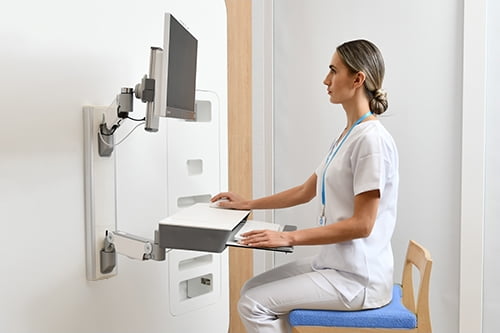
Clinicians spend a large percentage of time on patient documentation, medication administration and care coordination. The right wall-mounted workstation helps caregivers simplify workflow, provides access to electronic medical records, and allows them to remain close to and interact directly with their patients.
With many wall-mounted workstation options available today, how do facilities choose the right solution and implement successfully?
- Determining the Best Location
When choosing a location for a wall workstation there are several factors to consider. First, it is important to understand clinical workflow within the patient care unit and at the patient bedside. This may include the clinical documentation process (in-room or hallway), medication distribution, clinician walking and sit/stand patterns, and infection control procedures. The amount of floor space, wall space and storage space in patient rooms and hallways will also influence the type and location of a chosen workstation. Wall workstations in a patient room are best positioned close to the bedside to encourage patient interaction and the sharing of information. If charting is performed outside the patient room, workstations mounted in the hallway should have the ability to stow tightly to the wall to maximize space and meet building/fire code requirements.
- Patient Interaction
A wall workstation located at the point-of-care enables clinicians to complete documentation at the bedside, encourages communication and eye contact with the patient, and facilitates the sharing of pertinent information. When considering in-room mounting, assess the layout of the patient room, the location of furniture and other equipment, location of electrical outlets, and whether a wall workstation can be positioned close to the patient’s bedside.
- Ergonomics
Unlike a traditional office where employees work at individual desks that can be customized for each worker, healthcare workstations require tremendous flexibility to accommodate multiple users. When selecting wall workstations consider whether they offer:
- Keyboard and monitor adjustability to ensure the users hands and eyes are at the correct level to avoid awkward, uncomfortable postures.
- Simple height adjustment to support sitting and standing positions for multiple users
- A range of flexibility to comfortably accommodate all users varying physical requirements
- Ease-of-Use for Clinician and IT
Workstations should be intuitive and easy to adjust with minimal effort, providing comfortable and convenient computer access for multiple clinical users. Evaluate any additional requirements such as independent keyboard and monitor adjustability, ability for the monitor to swivel for patient viewing, and the arm extension or reach required to support one bed or two. Consider the cabling and cable management to minimize any visual clutter and to support easy cleaning. Can the workstation be customized with accessories to optimize clinical workflow such as bar code scanners, hardware and other peripherals? Lastly, think about IT’s access to the workstation and the ease of maintenance when required.
Selecting the right wall-mounted workstation optimizes workflow, provides an ergonomic documentation solution at the point-of-care, helps facilitate patient-caregiver communication and enhances patient care.